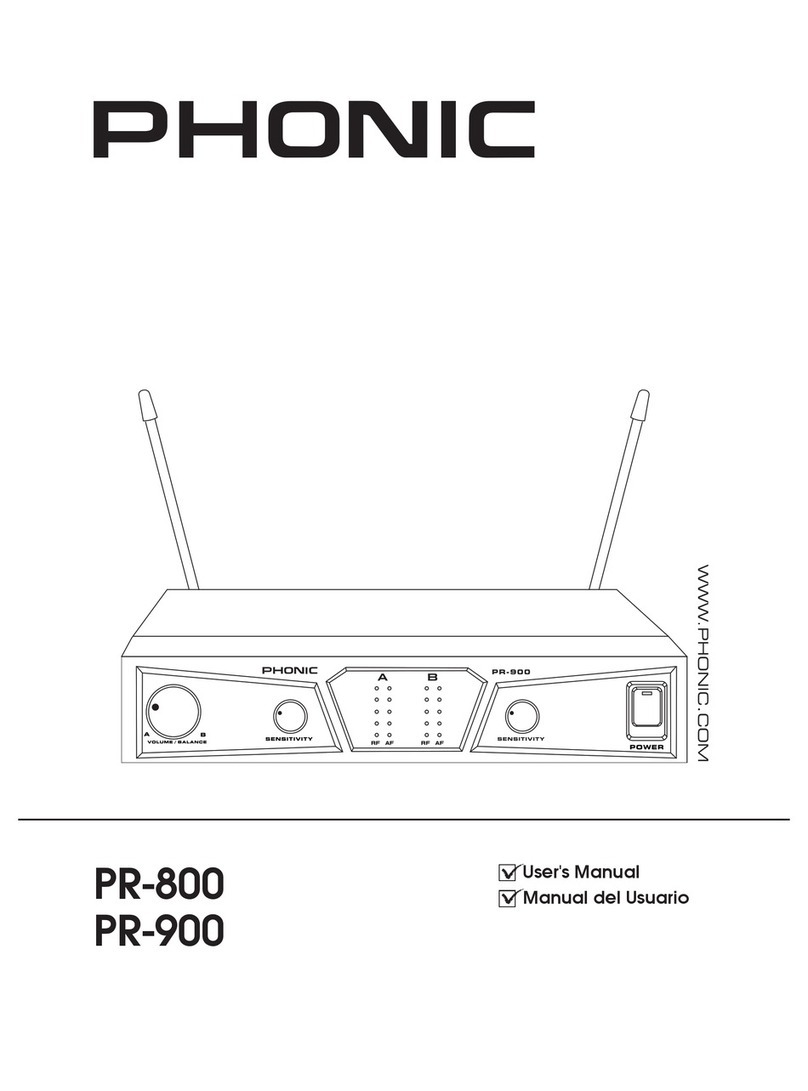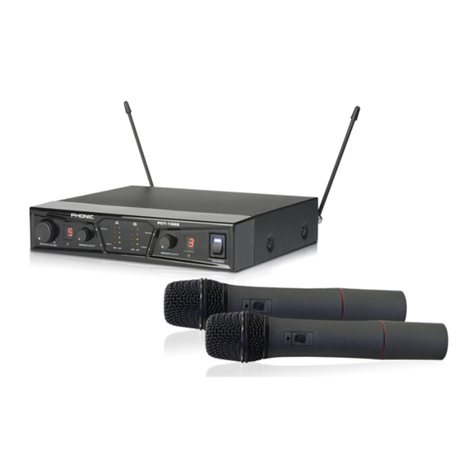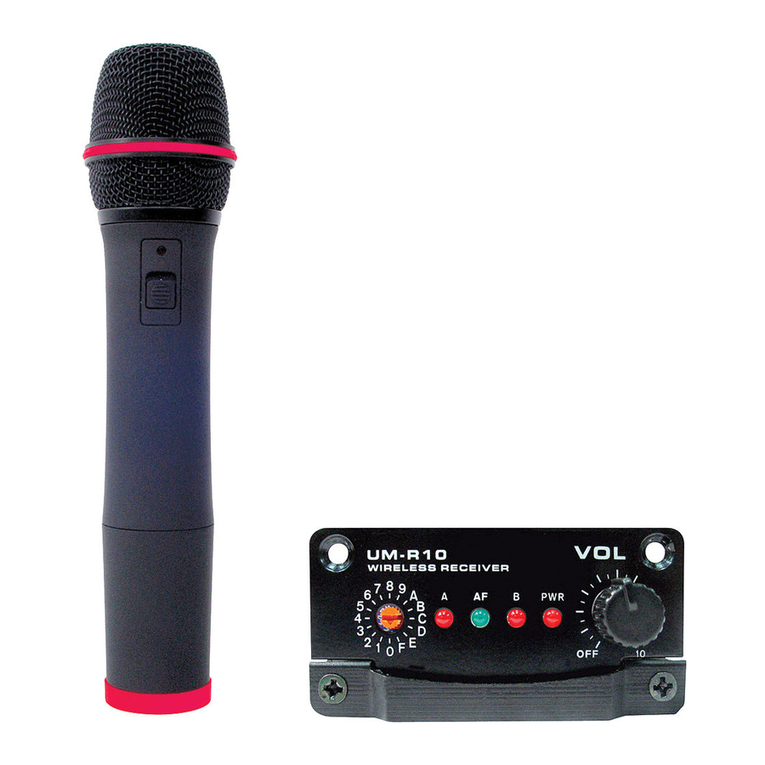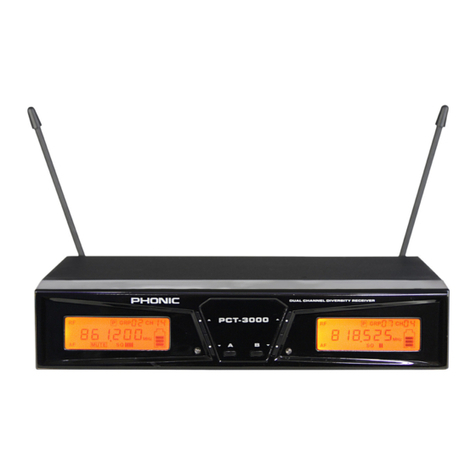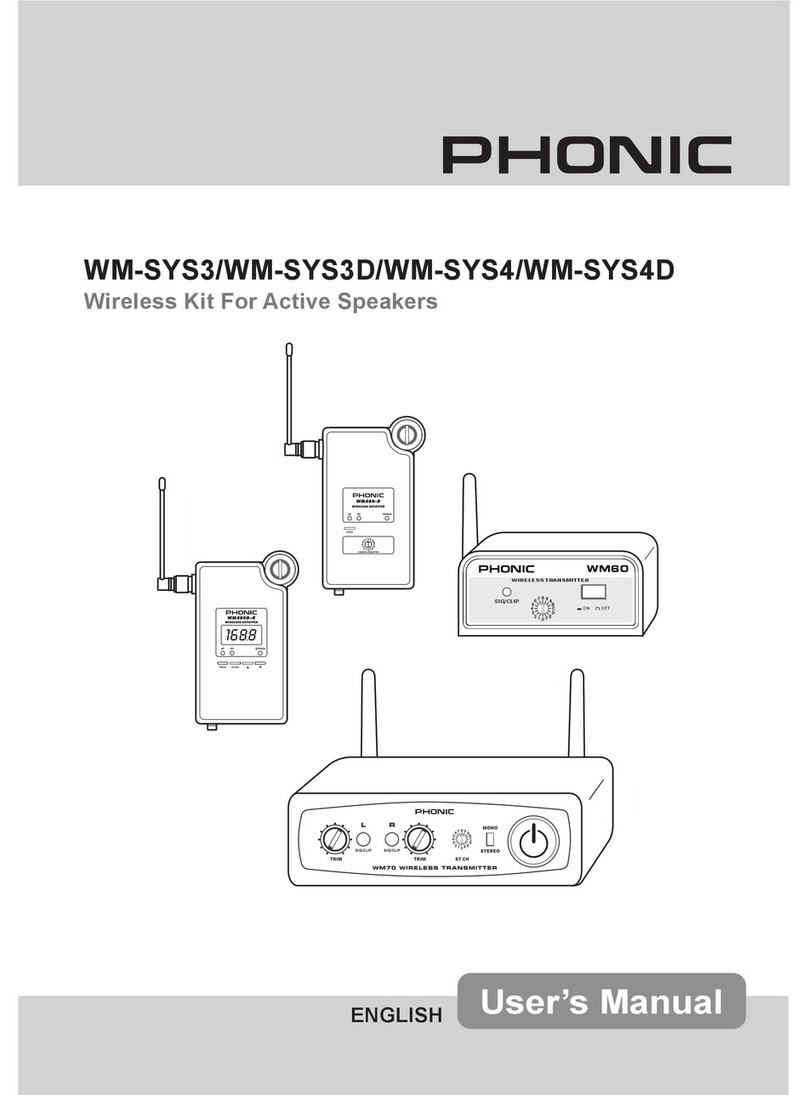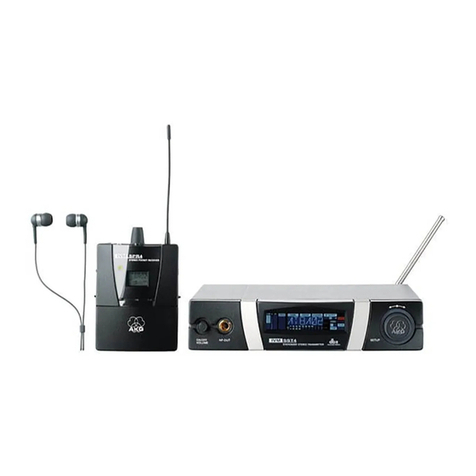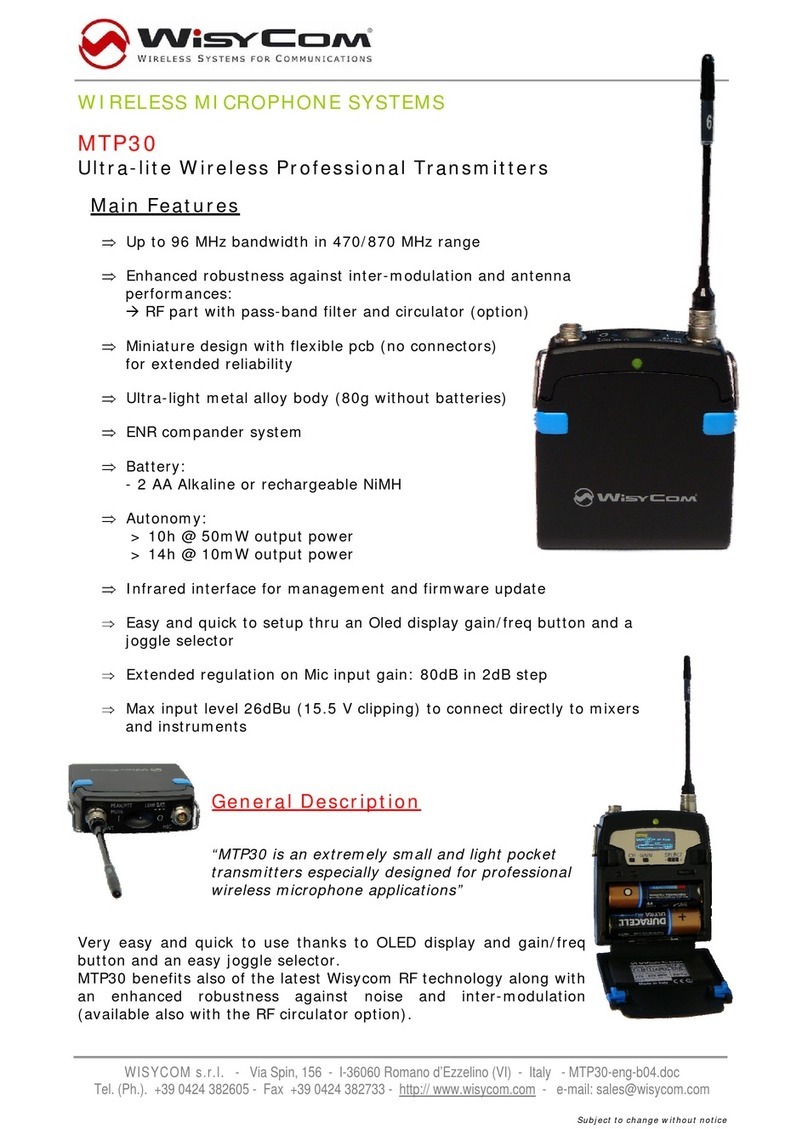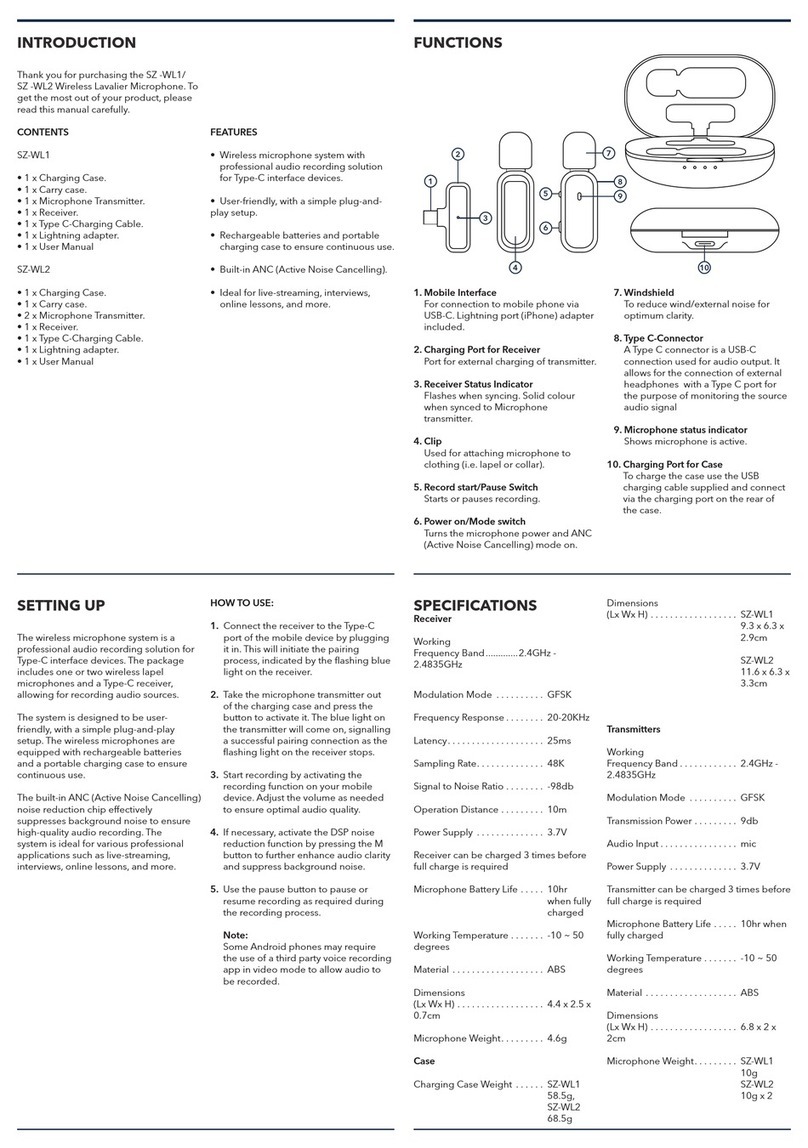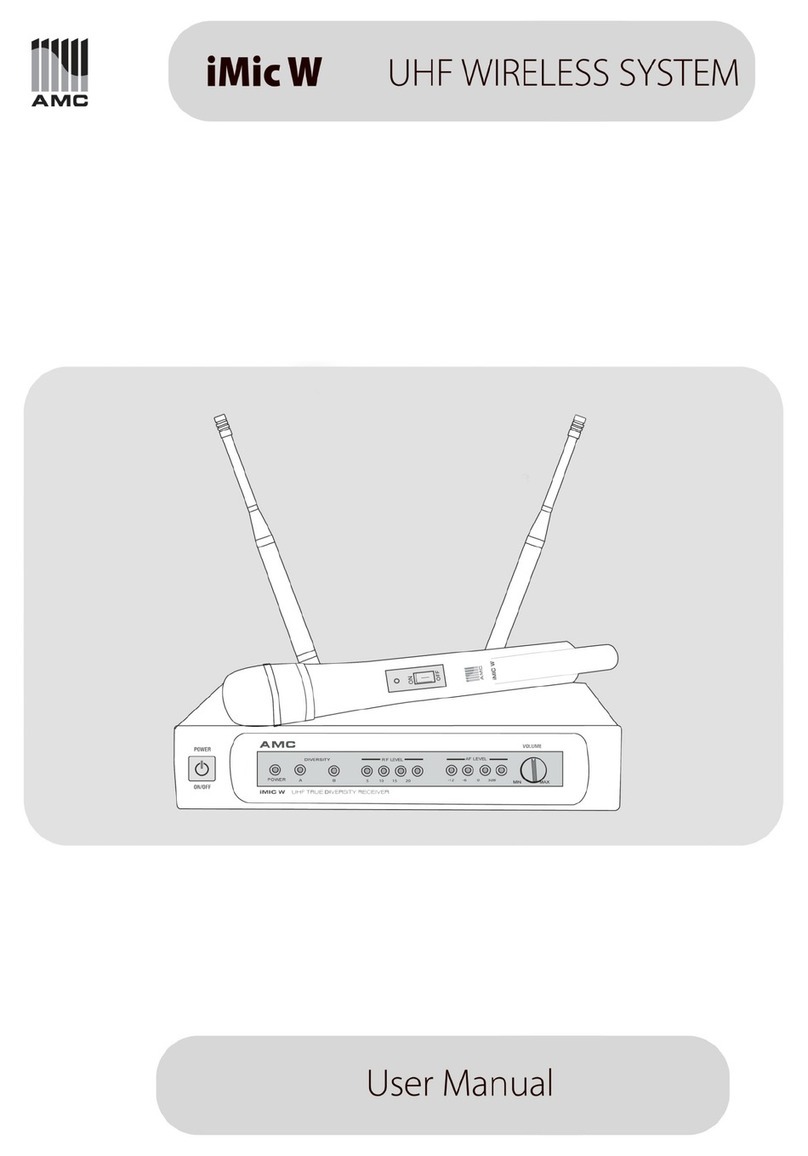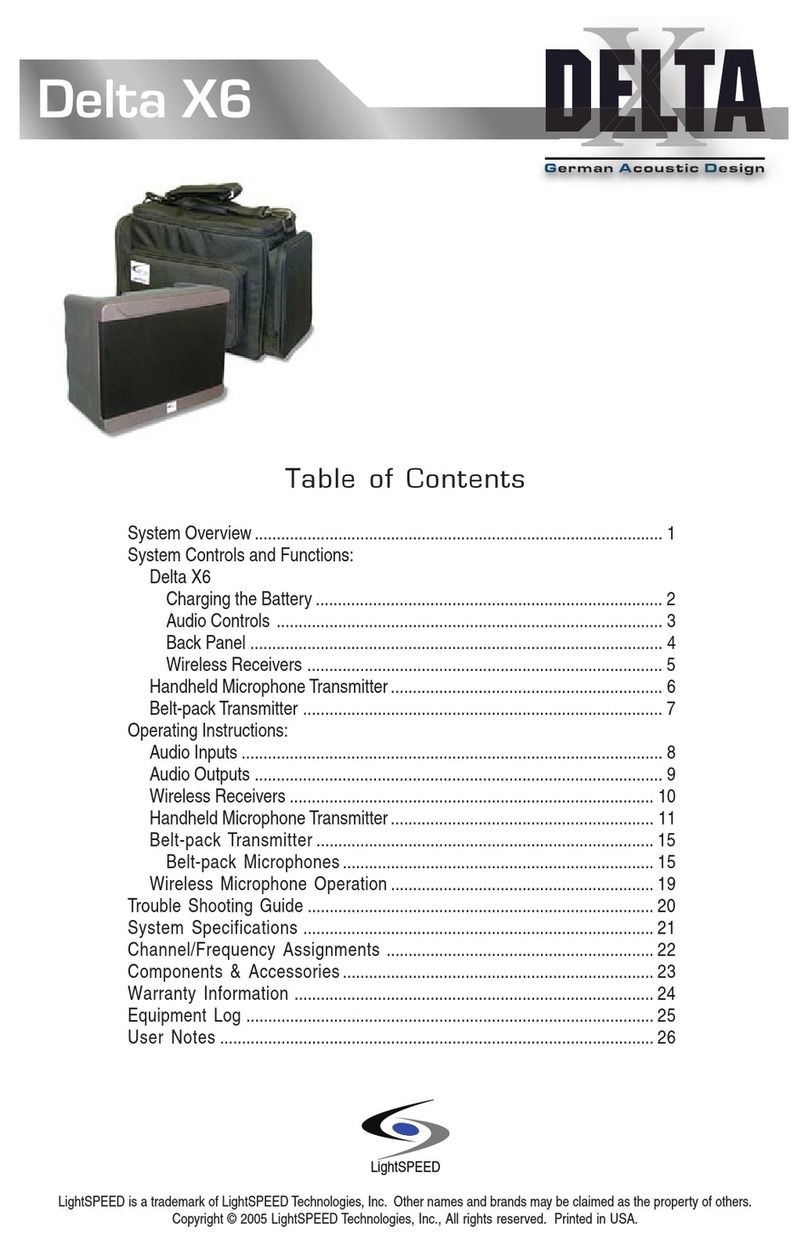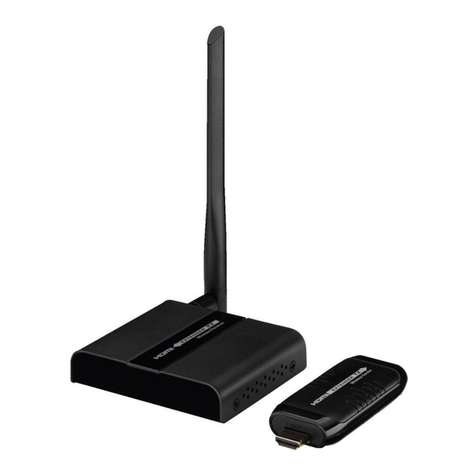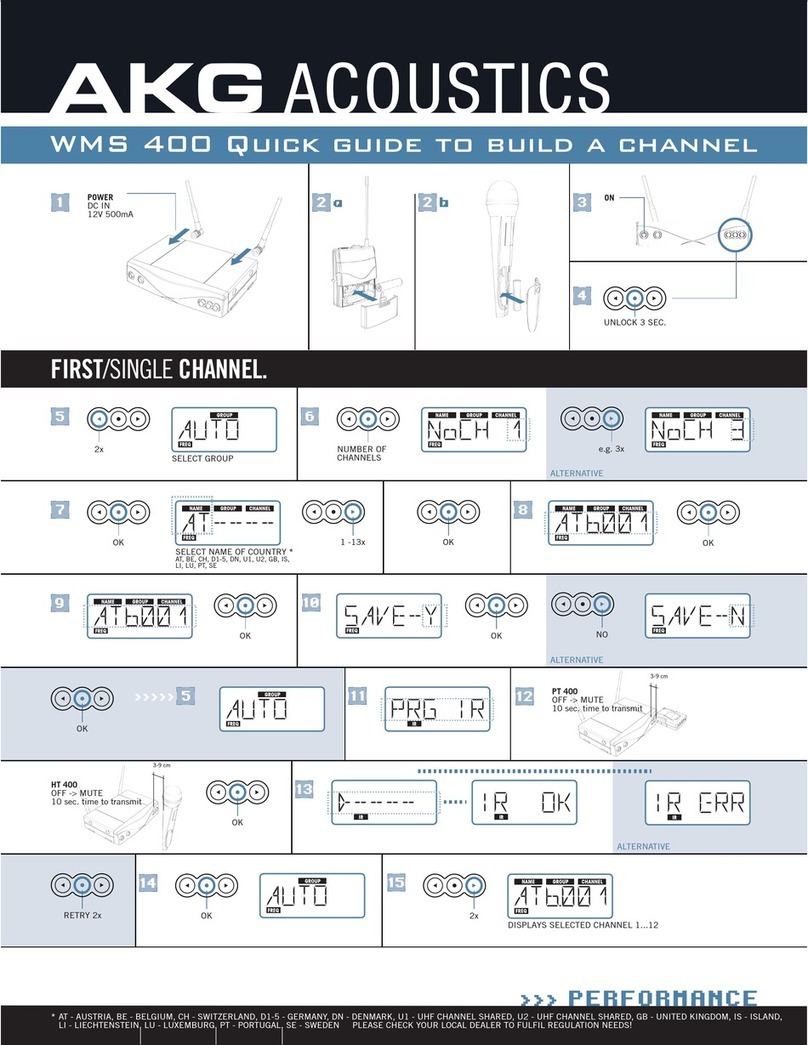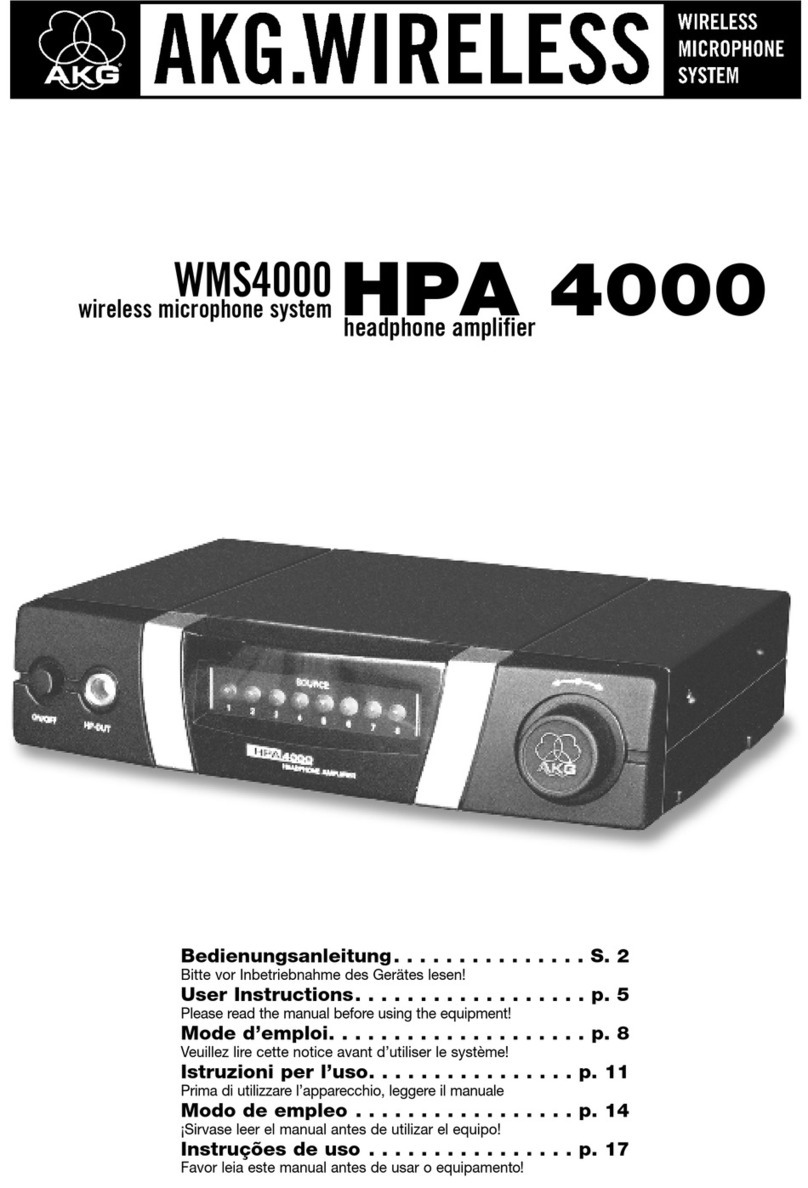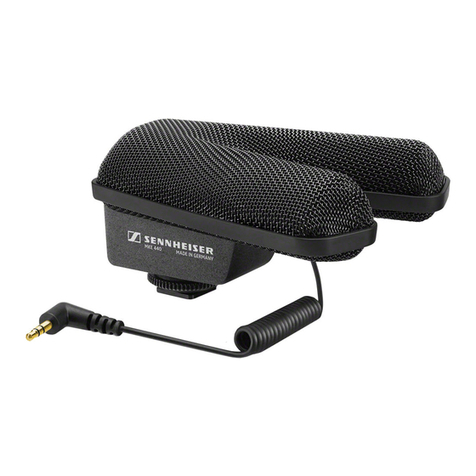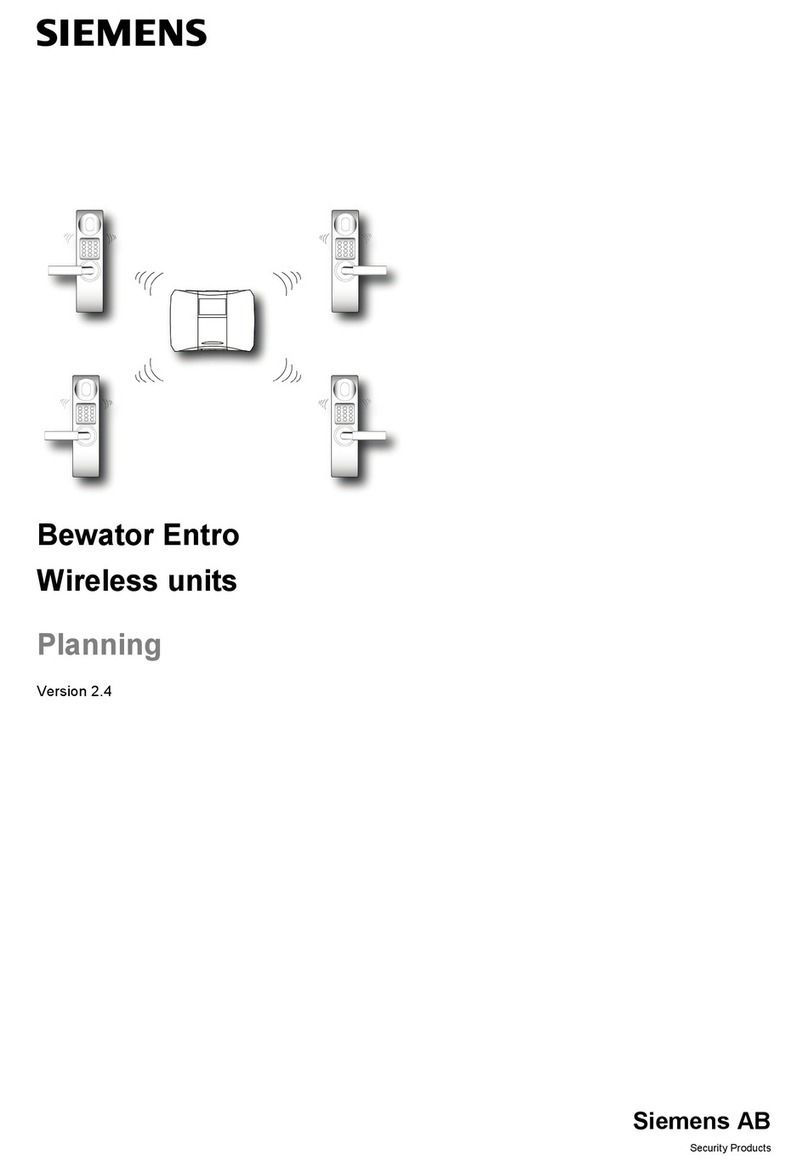Phonic WM Series User manual

1
WM SERIES
OFFON
SI G/CL I P
WIRELES S T R ANSMITTER
WM 6 0
User’s Manual
Manual del Usuario
使用手册
WM Series
Wireless Kit for Active Speakers
Kit Inalámbrico para Altavoces Activos
用于有源音箱的无线装置
English / Español /

INTRODUCTION...................4
SYSTEM COMPONENTS......4
FEATURES.............................5
QUICK SETUP........................6
WM60 TRANSMITTER.........8
WM70 TRANSMITTER..........8
WM40-LAND WM40-R
RECEIVERS..........................9
IMPORTANT...........................9
INSTALLINGTHEWM40-L AND
WM-40RINTHEPERFORMER
SPEAKERS..........................10
WM400(D) RECEIVERS......10
WM400(D) POWER
MODES..................................12
THE WM400D'S DIGITAL
FEATURES..........................13
CONNECTINGTHEWM400(D)
TO A SPEAKER...................14
SPECIFICATIONS...............15
EQ PRESETS OF WM400D-L
AND WM400D-R..................40
CONTENTS
INTRODUCCION........................17
COMPONENTES DELSISTEMA..17
CARACTERISTICAS..................18
CONFIGURACION RAPIDA........19
WM60 TRANSMISOR.................21
WM70 TRANSMISOR.................21
WM40-L Y WM40-R
RECEPTORES............................22
IMPORTANTE.............................22
INSTALANDO LOS WM40-L Y
WM40-R EN LOS ALTAVOCES
PERFORMER..............................23
RECEPTORES WM400(D).........23
MODALIDADES DEALIMENTACION
WM400(D)....................................25
CARACERISTICAS DIGITALES
DEL WM400D...........................26
CONECTANDO AL WM400(D) A
UN ALTAVOZ...............................27
ESPECIFICACIONES.................28
EQ PRESETS DEL WM400D-L Y
WM400D-R..................................40
CONTENIDO 目录
简介............................30
系统组件.....................30
特色............................30
快速安装.....................31
WM60发射器..............33
WM70发射器..............33
WM40-L和WM40-R
接收器........................34
重要提示.....................34
在Performer音箱上安装
WM40-L和WM40-R接收
器.................................34
WM400(D)接收器.......35
WM400(D)电源模式...36
WM400D的数字特点..37
连接WM400(D)和
音箱............................38
规格............................39
WM400D-L和WM400D-R
EQ预设表.....................40
Phonic preserves the right to improve or alter any information within this document without prior notice
Phonic se reserva el derecho de mejorar o alterar cualquier información provista dentro de este documento sin previo aviso
PHONIC保留不预先通知即可更新本手册的权利
V1.0 03/25/2009
WM Series
Wireless Kit for Active Speakers
Kit Inalámbrico para Altavoces Activos
用于有源音箱的无线装置

3
WM SERIES
5HDG WKHVH LQVWUXFWLRQV EHIRUH RSHUDWLQJ WKLV
DSSDUDWXV
.HHSWKHVHLQVWUXFWLRQVIRUIXWXUHUHIHUHQFH
+HHGDOOZDUQLQJVWRHQVXUHVDIHRSHUDWLRQ
)ROORZDOOLQVWUXFWLRQVSURYLGHGLQWKLVGRFXPHQW
'RQRWXVHWKLVDSSDUDWXVQHDUZDWHURULQORFDWLRQV
ZKHUHFRQGHQVDWLRQPD\RFFXU
&OHDQRQO\ZLWKGU\FORWK'RQRWXVHDHURVRORUOLTXLG
FOHDQHUV8QSOXJWKLVDSSDUDWXVEHIRUHFOHDQLQJ
'RQRWEORFNDQ\RIWKHYHQWLODWLRQRSHQLQJV,QVWDOO
LQDFFRUGDQFHZLWKWKHPDQXIDFWXUHU
¶
VLQVWUXFWLRQV
'R QRW LQVWDOO QHDU DQ\ KHDW VRXUFHV VXFKDV UDGLDWRUV
KHDWUHJLVWHUVVWRYHVRURWKHUDSSDUDWXVLQFOXGLQJ
'RQRWGHIHDWWKHVDIHW\SXUSRVHRIWKHSRODUL]HGRU
JURXQGLQJW\SHSOXJ$SRODUL]HGSOXJKDVWZREODGHV
ZLWKRQHZLGHUWKDQWKHRWKHU$JURXQGLQJW\SHSOXJ
KDVWZREODGHVDQGDWKLUGJURXQGLQJSURQJ7KHZLGH
EODGHRUWKHWKLUGSURQJLVSURYLGHGIRU\RXUVDIHW\,I
WKHSURYLGHGSOXJGRHVQRW LQWR\RXURXWOHWFRQVXOW
DQHOHFWULFLDQIRUUHSODFHPHQWRIWKHREVROHWHRXWOHW
3URWHFW WKH SRZHU FRUG IURP EHLQJ ZDONHG RQ RU
SLQFKHGSDUWLFXODUO\DWSOXJFRQYHQLHQFHUHFHSWDFOHV
DQGWKHSRLQWZKHUHWKH\H[LWIURPWKHDSSDUDWXV
2QO\XVH DWWDFKPHQWVDFFHVVRULHV E\ WKH
PDQXIDFWXUHU
8VH RQO\ ZLWK D FDUW VWDQG WULSRG EUDFNHW RU
WDEOH E\ WKH PDQXIDFWXUHU RU VROG ZLWK
WKH DSSDUDWXV :KHQ D FDUW LV XVHG XVH FDXWLRQ
ZKHQ PRYLQJ WKH FDUWDSSDUDWXV
FRPELQDWLRQWR DYRLG LQMXU\ IURP WLS
RYHU
8QSOXJWKLVDSSDUDWXVGXULQJOLJKWLQJ
VWRUPV RU ZKHQ XQXVHG IRU ORQJ
SHULRGVRIWLPH
5HIHU DOO VHUYLFLQJ WR VHUYLFH SHUVRQQHO
6HUYLFLQJLVUHTXLUHGZKHQWKHDSSDUDWXVKDVEHHQ
GDPDJHGLQDQ\ZD\VXFKDVSRZHUVXSSO\FRUGRU
SOXJLVGDPDJHGOLTXLGKDV EHHQVSLOOHGRUREMHFWV
KDYH IDOOHQ LQWR WKH DSSDUDWXV WKH DSSDUDWXV KDV
EHHQH[SRVHGWRUDLQRUPRLVWXUHGRHVQRWRSHUDWH
QRUPDOO\RUKDVEHHQGURSSHG
,03257$176$)(7<,16758&7,216
&$87,21725('8&(7+(5,6.2)(/(&75,&6+2&.
'21275(029(&29(525%$&.
1286(56(59,&($%/(3$576,16,'(
5()(56(59,&,1*7248$/,),('3(56211(/
7KH OLJKWQLQJ IODVK ZLWK DUURZKHDG V\PERO ZLWKLQ DQ
HTXLODWHUDO WULDQJOH LV LQWHQGHG WR DOHUW WKH XVHU WR WKH
SUHVHQFH RI XQLQVXODWHG
³
GDQJHURXV YROWDJH
´
ZLWKLQ WKH
SURGXFW
¶
PDJQLWXGHWRFRQVWLWXWHDULVNRIHOHFWULFVKRFNWRSHUVRQV
7KH H[FODPDWLRQ SRLQW ZLWKLQ DQ HTXLODWHUDO WULDQJOH LV LQ
WHQGHGWRDOHUWWKHXVHUWRWKHSUHVHQFHRILPSRUWDQWRSHUDW
LQJDQGPDLQWHQDQFHVHUYLFLQJLQVWUXFWLRQVLQWKHOLWHUDWXUH
DFFRPSDQ\LQJWKHDSSOLDQFH
:$51,1* 7RUHGXFHWKHULVNRI RUHOHFWULFVKRFNGR
QRWH[SRVHWKLVDSSDUDWXVWRUDLQRUPRLVWXUH
&$87,21 8VH RI FRQWUROVRU DGMXVWPHQWVRU SHUIRUPDQFH
RI SURFHGXUHV RWKHU WKDQ WKRVH PD\ UHVXOW LQ
KD]DUGRXVUDGLDWLRQH[SRVXUH
7KH DSSDUDWXV VKDOO QRWEH H[SRVHGWR GULSSLQJRU VSODVKLQJ DQG WKDWQR REMHFWV ZLWK OLTXLGV VXFKDV YDVHV
VKDOOEH SODFHG RQ WKH DSSDUDWXV 7KH 0$,16 SOXJLV XVHGDV WKH GLVFRQQHFW GHYLFH WKH GLVFRQQHFW GHYLFH VKDOO
UHPDLQUHDGLO\RSHUDEOH
:DUQLQJ WKH XVHU VKDOO QRW SODFH WKLV DSSDUDWXVLQ WKH DUHD GXULQJ WKH RSHUDWLRQVR WKDW WKH PDLQV VZLWFK
FDQEHHDVLO\DFFHVVLEOH
&$87,21
5,6.2)(/(&75,&6+2&.
'212723(1

4WM SERIES
INTRODUCTION
Congratulations on your purchase of the WM
series of wireless kit for use with active speak-
ers. With either the stereo or mono WM kits,
you are now fast on your way to becoming
completely wireless in your audio set up. The
WM modules are not only fantastic in style
and convenience, however; they are incred-
ibly easy to use, as this manual will no doubt
prove.
Please have a thorough read of this user’s
manual before operating the WM modules.
Inside this guide you will nd information on
the ease of your wireless set up, as well as
some great troubleshooting tips and a com-
plete run-down on your modules’ features.
After reading, place the manual in an easy to
remember place so that you can come back
to it in future if ever necessary.
SYSTEM COMPONENTS
WM-SYS1 includes:
1x WM60 single channel transmitter
1x WM40-L receiver module
WM-SYS2 includes:
1x WM70 dual channel transmitter
1x WM40-L left channel receiver module
1x WM40-R right channel receiver module
WM-SYS3(D) includes :
1x WM60 single channel transmitter
1x WM400(D)-L receiver
2x power supplies for WM60 and WM400(D)-L
M6, M8, M10 screws
Velcro strip
WM-SYS4(D) includes :
1x WM70 dual channel transmitter
1x WM400(D)-L left channel receiver
1x WM400(D)-R right channel receiver
3x power supplies for WM70, WM400(D)-L and
WM400(D)-R
M6, M8, M10 screws
Velcro strip

5
WM SERIES
FEATURES
Common Features
●Wireless system for saving the audio ca-
bles between your mixer and active
speakers
●16 user-selectable frequencies
●RF carrier frequency range :
614.175~804.800 MHz (FCC)
614.175-864.800 MHz (CE)
●Operating range: 165-210ft. (50-70m, en-
vironment dependent)
●Internal squelch and mute circuit mode
can resist extraneous noise
WM60 Additional Features
● Single channel stand-alone transmitter
● Signal/Clip indicator
● External power supply
WM70 Additional Features
● Dual channel stand-alone transmitter
● Signal/Clip indicator
● Volume control to set the appropriate
level to avoid clip
● Mono/Stereo switch for easy setting in
mono or stereo sound system
● 16 preset channel encoder will decide
the left and right channel frequencies
automatically
● External power supply
WM40-L & WM40-R Additional Features
● Left or Right channel receiver module to
be installed in any Phonic Performerpow-
ered speaker
● Power indicator
● True diversity receiving mode
WM400-L&WM400-R Additional Features
●
Stand-alone UHF wireless recei
ver,
working with any active speakers
●Indicators for power on, AF and RF
●Antenna: external, threaded connector
● M6, M8, M10 screws and velcro strip
included for at
taching receiver unit to any
a
ctive speakers
●
Audio output connectors: XLR out
● 12 VDC external power supply (country
dependent)
WM400D-L & WM400D-R plus:
●300 ms digital delay processor for
compensation of different distance
speakers
●0.1 millisecond to 300.0 millisecond delay
range, delay adjustment may be made
with 0.1 millisecond precision
●30 preset EQ curves and variable high cut
and low cut lters
●4-digit display to indicate frequency
channel and delay, plusAF, RF and delay
bypass indicators

6WM SERIES
QUICK SETUP
Single Channel Setup
Users are able to wirelessly send a monau-
ral signal through the WM60 transmitter and
WM40-L/ WM400(D)-L receiver.
1. Plug the mixer’s main output (with a line-
level signal) to either the XLR or 1 /4” input
of the WM60 transmitter.
2. Connect the provided DC power supply to
the WM60’s and WM400(D)-L’s power in-
put and an appropriate AC power source
and turn it on.
3. Adjust the channel on both the WM60 and
WM40-L/ WM400(D)-L so they are identi-
cal. If you wish to send and receive a signal
successfully, this is of utmost importance!
4.
Adjust the WM60’s and WM400(D)-L
’s
antenna into a vertical position.
5. SYS1: Slide the WM40-L receiver into
the Performer’s Wireless Module Recepta-
cle on the top right hand side of the speak-
er (right hand side, when facing the rear of
the speaker ) and screw it
into place. Be
sure to move the module’s
antennas (pro-
truding from the case) to either side of
the module. Ideally, the antennas should
be taped to the wall of the module slot.
SYS3: Attach the WM400(D)-L to the
speakerby H6,H8screwsorvelcro strip.
Connect the WM400(D)-L’s XLR output
to the input of your active speaker.
6. SYS1: Set the WIRELESS / WIRELESS
MIC switch on the rear panel of the Pho-
nic performer speaker to the “Wireless”
Position, and set the wireless volume
control to around 3 o’clock position.
SYS1/SYS3: Turn the WM60 on rst ,
then the WM40-L or WM400(D)-L.
7. SYS1: Turn the WM60 on rst, then the
Performer Speaker.
8.
Provided you have a signal going out
of your mixer, and your Speaker is
turned on, the wireless transmission
should be working.
WM-SYS1: Single Channel Setup WM-SYS3: Single Channel Setup
WM40L is inside the slot of
Phonic Performer speaker
OFFON
SIG/CLI P
WIRE LE SS T R ANSMI T TE R
WM60
WM60
WM400-L
Any active speaker
OFFON
S IG/CLI P
WIRE LE SS TR AN SMIT TE R
WM60

7
WM SERIES
Dual Channel Setup
Users are able to wirelessly send ste-
reo signals through the WM70 transmitter
and WM40-L / WM40-R or WM400(D)-L /
WM400(D)-R receivers.
1. Plug the mixer’s main stereo output (with a
line-level signal) to the left and right inputs
(both XLR and 1 /4” inputs can be con-
nected to the combo-jacks) of the WM70
transmitter.
2. Connect the provided DC power supply to
the WM70’s and WM400(D)’s power input
and an appropriate AC power source.
3. Adjust the channel on the WM70 and both
WM40s/ WM400(D)’s so they are identical.
If you wish to send and receive a signal
successfully, this is of utmost importance!
4. Make sure the WM70 is switched to “ste-
reo” mode.Turn the left and right level con-
trols to around 3 o’clock position.
5. SYS2: Insert the left and right antennas
into the left and right antenna plugs on the
WM70, and leave them sitting vertically
for
the best range.
SYS4: Attach the WM400(D) to your active
speaker by the included M6, M8 and M10
screws or velcro strip.Connect appropri-
ate audio cables to the WM400(D)s’ XLR
outputs and your speakers’ inputs.
6. SYS2: You can then insert the WM40-L and
WM40-R receiver modules into the Phonic
Performers’ wireless module receptacles
on the top right hand side (when facing
the rear of the speaker) of the speakers
(Use the WM40-L on your left speaker, the
WM40-R on your right). Move the modules’
antennas (protruding from the case) and
tape them to each side of the module slot.
7. SYS2/SYS4: Set the WIRELESS / WIRE-
LESS MIC switch on the rear panel of the
Phonic performer speaker to the “Wire-
less” Position, and set the wireless volume
control to around 3 o’clock position.
8. Turn the WM70 on rst, then the Performer
Speaker.
9. Provided you have a signal going out of
your mixer, and your Speaker is turned on,
the wireless transmission should be work-
ing.
WM-SYS4: Dual Channel Setup
WM-SYS2: Dual Channel Setup
WM40-L & WM40-R is inside the
slot of Phonic Performer speaker
WM70 WM400-R
WM400-L
Any active speaker

8WM SERIES
WM60 TRANSMITTER
Front Panel
1. Sig/Clip Indicator – the LED indicator will
light up green when a signal is being re-
ceived by the WM60 transmitter. It will turn
red when the signal level becomes exces-
sive, just 4dB before clipping.
2. Channel Selector – adjusting this dial
to one of the preset channels allows the
WM60 to know which frequency to send
the wireless information at. The wireless
receivershould be setto the identicalchan-
nel if transmission is to occur successfully.
3. On/Off Button – this button turns the
WM60 on and off.
4. Antenna – this is the WM60’s antenna.Ad-
just it so it sits in a vertical position when
the device is in use (change the position
if the wireless signal quality is poor). Push
the antenna in to release it before adjust-
ing its position.
Rear Panel
5. 1/4” Input – this jack accepts balanced
and unbalanced 1/4” inputs from line-level
sources.
6. XLR Input – this jack accepts balanced
XLR inputs from line-level sources. Both
the 1/4” jack and the XLR jack run in par-
allel.
7. DC In – plug DC end of the supplied DC
power adaptor into this jack, and the other
end into a suitable AC power source to al-
low the WM60 to be powered. Please en-
sure you use the DC power supply (12V,
300mA) provided with this unit, as using
another power supply could cause dam-
age.
WM70 TRANSMITTER
Front Panel
1. Left and Right Sig/Clip Indicators – the
LED indicator will light up green when
a signal is being received by the WM70
transmitter. It will change to red when the
signal level becomes excessive, just 4dB
before clipping.
2. Trim Control – these controls adjust the
level of the signal received via the Combo
inputs on the rear that will be sent wire-
lessly.
3. Channel Selector – adjusting this dial
to one of the preset channels allows the
WM70 to know which frequency to send
the wireless information at. Each preset
channel will transmit both the left and right
signals, so that the WM40-L, WM40-R,
WM400(D)-L and WM400(D)-R wireless
receivers (if set to the identical channel)
will receive the signal successfully.
OFFON
SIG/CL IP
WIRELES S T RA NSMITTE R
WM 6 0
2 31
4
DC I N I NP U T
756

9
WM SERIES
4. Stereo/Mono Selector – This will allow
users to change the wireless signal sent
from the WM70 to be alternated between
a mono and stereo signal.
5. On/Off Button – this button turns the
WM70 on and off. An LED will illuminate
under this button when it is on.
Rear Panel
6. Left and Right Combo Input – this jack
accepts both balanced and unbalanced
1/4” and XLR inputs from line-level sources
(such as the main output of a mixer).
7. Left and Right Antennas – this for the in-
sertion of the WM70’s left and right anten-
nas. Insert the antennas and adjust them
to sit in a vertical position when the device
is in use. Screw the antenna in to lock it
into place.
8. DC In – plug DC end of the supplied DC
power adaptor into this jack, and the other
end into a suitable AC power source to al-
low the WM70 to be powered. Please en-
sure you use the DC power supply (12V,
750mA) provided with this unit, as using
another power supply could cause dam-
age.
WM40-L AND WM40-R
RECEIVERS
Insert the wireless receivers into the Active
Performer Speakers to allow them to receive
signals sent by the wireless transmitters.
These modules should be inserted and xed
into the right hand side (when facing the rear
of the speaker) compartment at the top of
the speaker, and screwed into place with an
M3x4 screw.
1.ChannelSelector-adjustingthisdialtoone
of the preset channels allows the WM40 to
know which frequency to look for the wire-
less information. The wireless transmitter
should be set to the identical channel if
transmission is to occur successfully.
2. On Indicator– this LED indicator illumi-
nates when the WM40 Receiver is pow-
ered.
3. Antenna– The wireless receiver’s antenna
comes in the form of 2 small wires protrud-
ing from the casing. When you insert the
module into the appropriate slot on the
Performer speaker, it is best to sticky-tape
the antennas to either side of the compart-
ment wall.
IMPORTANT
Whenever using the WM40L or WM40R,
the included short pin should be inserted
into the unused wireless microphone mod-
ule slot to enable the wireless module to
be used.
1 2
3

10 WM SERIES
WM400(D) RECEIVERS
These wireless receivers can be used in con-
junction with any active speaker. The receiver
can be attached to the speaker by screwing it
into the stand’s screw socket.
1. 4 Digit Display(WM400D-L and WM400D-
R only) – This display will allow users to
see the properties that are currently in use
by the WM400D, whether you are adjust-
ing the receiver channel (indicated by CH),
the EQ settings (indicated by EQ), the de-
lay time (indicated by only the delay time
in milliseconds) or the high and low pass
lters (indicated by a H or L, respectively).
This display will light up when the device is
turned on.
2. AF Indicators
– When this LED
is illuminated, it in-
dicates that there
is an audio signal
being received by
the WM400(D) re-
ceiver.
3. RF Indicators – When the RF indicator il-
luminates, it shows that the transmitter’s
signal is being received successfully. If for
some reason this LED does not turn on,
check your DC power input and pre-set
channel conguration and try again.
4. Bypass Indicator( only for WM400D-L
and WM400D-R) - this LED will light up
when the digital processing feature of the
WM400(D) receiver is off.
5. Power Button – hold this button down for 2
seconds to power up the unit.
1
2
3 4
6
57
5
INSTALLING THE WM40-L
AND WM40-R IN THE PER-
FORMER SPEAKERS
1. Unscrew the module cover (on the top-right,
while facing the rear of the speaker) on the
Performer speaker.
2. Slide the WM40 module into the socket.
3. Use the provided screw to fasten the WM40
module to the Performer speaker.
4. Use sticky
–
tape to attach the 2 antenna
wires to the rear-inner wall of the module
slot, ensuring they do not cross one another.
This will allow for greater quality of recep-
tion.
5. Replace the module cover.

11
WM SERIES
6.BypassButton (WM400D-LandWM400D-
R only) – push this button to turn the digital
processing feature on and off.
7. Up and Down Buttons (WM400D-L and
WM400D-R only) – these buttons are used
to adjust the properties of various features
built-into the WM400D’s. Pushing up or
down will initially simply allow users to ad-
just the channel that the transmitter is us-
ing. If you push both of these buttons at
the same time, it will jump to the next set-
ting that can be edited. You can then adjust
the properties by pushing the up and down
buttons. These settings will come in the fol-
lowing order:
Channel Settings :
CH 0 – CH 9, CH A – CH F
Delay Settings :
0.0 – 300.0 milliseconds
EQ Mode :
P1 – P30 (see the EQ table for
a full rundown on EQ presets)
Low Cut Filter :
L 20 (Hz) – L 12 (kHz)
High Cut Filter :
H 20 (kHz) – H 60 (Hz)
(High and low cut lters are adjusted in 1 Hz
increments; 10Hz increments above 1kHz)
8. Channel Selector (WM400-Land WM400-
R only) – adjusting this dial to one of the
preset channels allows the WM400 to
know which pre-set frequency to look for
the wireless information. The wireless
transmitter should be set to the identical
channel if transmission is to occur suc-
cessfully.
9. Power Indicator (WM400-Land WM400-R
only) – this LED indicator illuminates when
the WM400 receiver is powered.
10. Antenna – this is the WM400(D)’s anten-
na. Adjust it so it sits in a vertical position
when the device is in use (change the po-
sition if the wireless signal quality is poor).
Push the antenna in to release it before
adjusting its position.
11. DC In and clip – plug DC end of the sup-
plied DC power adaptor (12V DC, 200mA)
into this jack, and the other end into a
suitable AC power source to allow the
WM400(D) to be powered. The accom-
panying clip ensures the DC head of the
power supply is kept securely in place.
12. XLR Output – this jack accepts XLR con-
nectors to feed the signal from the Wire-
less Receiver to the Speaker.
13. Fixing – Use this hole to secure the
WM400(D) receiver into the mounting
socket of your speaker by using accom-
panying M6, M8 or M10 screws.
13
9
8
5
10
11 12

12 WM SERIES
WM400(D) POWER MODES
Since some users will mount their WM400(D)
with a speaker in a high position, Phonic
thought it would be handy to make it so us-
ers could keep the power on constantly, as
long as power is supplied to the unit and thus
avoiding having to climb up high to push the
power button. To make this adjustment, users
are advised to follow the follow procedure:
1. Remove the two screws on the rear of the
WM400(D) receiver and the antenna.
2. Remove the screw on the bottom of the
WM400(D) beside the XLR output (the
screw closer to the rear panel).
3. Remove the rear section of the casing by
gripping the WM400(D) on both sides,
squeezing and lifting up, in the process
detaching the small clips within the cas-
ing.
4. A small switch should be visible on the
PCB. Flick it to the left to ensure the power
of the WM400(D) does not turn off without
you pushing the power button.
5. Be sure to replace the casing and screws
before using the WM400(D) receiver.
Unscrew the antenna
Unscrew the two screws
located on the rear panel
Unscrew the screw on
just below the XLR jack
Move the switch to the left to ensure the
power i s always on. T o the right, the
power button will need to be pushed and
held down to turn the unit on.

13
WM SERIES
Channel Mode
The channel number of the WM400D will be
displayed in the 4 digit display, unless adjust-
ments are being made to other feature’s prop-
erties. The channel number set should match
that of the WM60 or WM70 transmitter to al-
low the wireless system to work successfully.
Delay Mode
Changing the delay allows audio engineers to
compensate for the distance between speak-
ers on stage and audience members at the
rear of the venue. Using the delay effect on a
speaker at the rear will ensure the audio from
the stage reaches audience members at the
rear at approximately the same time as the
audio from the rear-speaker. The delay time
is adjusted in 0.1 millisecond increments, be-
tween 0 and 300 milliseconds (holding the up
or down button down speeds up the adjust-
ment time)
EQ Mode
The different EQ modes allow users to adjust
various frequencies of audio to enhance cer-
tain instruments, remove sibilance, feedback
and other undesirable noises, and improve
the overall delity of sounds. There are 30
presets to choose from (check EQ Preset
page for more information), the titles of which
describe what the effect does to your audio.
The default setting, P0, is completely at.
Low Cut Filter
A low cut lter allows users to cut low frequen-
cy sounds, ensuring stage rumble and other
unwanted low-frequency sounds are removed
from your audio. This can also help adjust the
frequency to be more suitable for use with
tweeters. The low cut lter’s cut off frequency
is adjusted in 1 Hz increments (10 Hz incre-
ments over 1kHz) between 10 Hz and 12 kHz.
The default setting is 20 Hz.
High Cut Filter
The high cut lter allows users to remove
unwanted high-frequency sounds, which can
help to remove high frequency hiss and feed-
back, as well as make the audio signal more
suitable for use with subwoofer speakers.
The high cut lter’s cut off frequency is ad-
justed in 1 Hz increments (10 Hz increments
over 1kHz) between 20 kHz and 60 Hz. The
default setting is 20 kHz.
TROUBLESHOOTING
No signal?
●Ensure both transmitter and receiver are
set to the same channel.
● Check the power lights on both receiver
and transmitter. If one of them is off, check
the device’s power supply is connected
correctly.
●
Make sure the “wireless” volume control on
the Performer speakers is turned up (WM-
SYS1 and WM-SYS2 only).
Weak signal?
●Trymaintaininga better line-of-site connec-
tion between the transmitter and receiver.
●Change both transmitter and receiver to a
new frequency.
Poor quality signal?
●It is important to remember that no other
devices should be sending signals on the
same frequency channel that you are us-
ing.
●If another device is found on the same
frequency channel, nd another suitable
channel.
THE WM400D’S DIGITAL FEATURES

14 WM SERIES
Velcro-Hooks Velcro-Hooks
Velcro-Hooks
Velcro-Loops
Velcro-Hooks
Velcro-Hooks
Velcro-Loops
CO
NNE
C
TIN
G
THE WM400
(
D
)
T
O
A
S
PEAKER
Users can connect the WM400(D) Receiver modules to an active speaker using
a mounting point or the included velcro strips, as indicated..
Mounting Point Velcro Strip

15
WM SERIES
SPECIFICATIONS
WM60
Type : Single Channel Transmitter
RF Frequency : 614.175~804.800 MHz (FCC)
614.175-864.800 MHz (CE)
Oscillation Type : PLL
Preset Channels : 16 Channels
Frequency Response : 50 Hz ~ 18 kHz ±3dB
Bandwidth : 24 MHz
Stability : ± 0.005%
Frequency Deviation : ± 40 kHz
LED Indicators : Power On/Off, Sig/Clip
Power : External Adaptor, 12 VDC
Output Power : <50 mW
Dimensions : 98x35x126 mm
(2.83” x 1.38” x 4.96”)
Net Weight : 350 g ( 0.77 lbs)
WM70
Type : Dual Channel Transmitter
RF Frequency : 614.175~804.800 MHz (FCC)
614.175-864.800 MHz (CE)
Oscillation Type : PLL
Preset Channels : 16 Channels (stereo)
Frequency Response : 50 Hz ~ 18 kHz ±3dB
Bandwidth : 24 MHz
Stability : ± 0.005%
Frequency Deviation : ± 40 kHz
LED Indicators : Power On/Off, Sig/Clip
Power : External Adaptor, 12 VDC
Output Power : <50 mW
Dimensions : 140 x 43.5 x 179 mm
(5.5” x 1.7” x 7”)
Net Weight : 325 g (0.72 lbs)
WM400-L and WM400-R
RF Sensitivity : -100 dBm
Image Rejection : 75dB
T.H.D. : <0.5% @ 1KHz
LED indicator : Power On, RF, AF
Squelch : Pilot Tone & Noise Mute
Audio Output Connector : XLR
Output Impedance : 200Ω
Power Requirement : 12VDC, 200mA external
power supply (country dependent)
Dimensions : 88.5 x 133 x 36.7 mm
(3.5” x 5.2” x 1.4”)
Net Weight : 145 g (0.32 lbs)
WM400D-L & WM400D-R
Digital Delay : 0.1 millisecond to 300.0
millisecond delay range, delay
adjustment may be made with
0.1 millisecond precision
Extra features : 30 preset EQ, Low-cut and
High-cut lter
Display : 4-digit display for delay time,
frequency channel, EQ mode and
Hi-cut/Lo-cut modes
Controls : power on/off, bypass,
up and down
WM40-L and WM40-R
Type : Single Channel Receiver
Preset Channels : 16 Channels
RF Frequency : 614.175~804.800 MHz (FCC)
614.175-864.800 MHz (CE)
Frequency Stability : –0.005%
S/N Ratio : >100 dB
RF Sensitivity : -100 dBm
Image Rejection : 75 dB
T.H.D. : <0.5% @ 1 kHz
LED Indicator : Power On
AF Output Impedance :
Squelch : Pilot Tone & Noise Mute
Operation Voltage : 6 ~ 8 VDC, 500 mA


17
WM SERIES
INTRODUCCION
Felicidades por tu compra del kit inalámbrico
de la serie WM, para ser utilizado con
altavoces activos. Ya sea con el kit mono
o estéreo, ya estas en tu camino de
convertir tu sistema de audio en un sistema
completamente inalámbrico. Los módulos
WM no solo son fantásticos en estilo y en
conveniencia, también son increíblemente
fáciles de utilizar, y este manual probará su
sencillez y simplicidad.
Por favor dé un vistazo completo y lea
este manual del usuario antes de utilizar
los módulos WM. Dentro de esta guía
encontraras información acerca de la sencilla
conguración inalámbrica, así como grandes
consejos para solucionar problemas y una
explicación completa de las características
de los módulos. Después de que leas este
manual, guárdalo en un lugar de fácil acceso
y fácil de recordar para futuras consultas.
COMPONENTES DEL SISTE-
MA
WM-SYS1 incluye:
1x WM60 transmisor de un solo canal
1x WM40-L módulo receptor
WM-SYS2 incluye:
1x WM70 transmisor de canal dual
1x WM40-Lmódulo receptor de canal
Izquierdo
1x WM40-R módulo receptor de canal
Derecho
WM-SYS3(D) incluye :
1x WM60 transmisor de un solo canal
1x WM400(D)-L receptor
2x Fuentes de alimentación para el WM60 y
WM400(D)-L
Tornillos M6, M8, M10
Tira de Velcro
WM-SYS4(D) incluye :
1x WM70 transmisor de canal dual
1x WM400(D)-L módulo receptor de canal
Izquierdo
1x WM400(D)-R módulo receptor de canal
Derecho
3x Fuentes de alimentación para el WM70,
WM400(D)-L y WM400(D)-R
Tornillos M6, M8, M10
Tira de Velcro

18 WM SERIES
CARACTERISTICAS
CARACTERISITCAS COMUNES
● Sistema inalámbrico para eliminar los
cables de audio entre tu mezcladora y tus
altavoces activos
● 16 frecuencias seleccionables por el usuario
● Rango de frecuencia de la portadora de
RF:
614.175~804.800 MHz (FCC)
614.175-864.800 MHz (CE)
● Rango de operación: 165-210 pies. (50-
70m, dependiendo del ambiente)
● Circuitos de Squelch y Mute internos
para resistir ruido externo
WM60 Características Adicionales
● Transmisor stand-alone de un solo canal
● Indicador Signal/Clip (Señal / Recorte)
● Fuente de alimentación externa
WM70 Caraterísticas Adicionales
● Transmisor stand-alone de un canal
dual
● Indicador Signal/Clip (Señal / canal dual)
● Control de volumen para ajustar
adecuadamente los niveles para evitar clip
en la señal
● Selector Mono/Estéreo para fácil con-
guración de sistema mono o estéreo
● 16 presets de canales de codicación
que decidirán las frecuencias de canales
Izquierdo y derecho automáticamente
● Fuente de alimentación externa
WM40-L & WM40-R Características
Adicionales
● Módulo receptor de canal izquierdo o
derecho para ser instalado en cualquier
altavoz Performer de Phonic
● Indicador de encendido
● Módulo receptor con sistema verdadero
True Diversity
WM400-L&WM400-R Características
Adicionales
●
Receptor Stand-alone UHF inalámbrico,
funciona con cualquier altavoz activo
● Indicadores para Encendido, AF y RF
● Antena: externa, conector roscado
● Tornillos M6, M8, M10 y tira de velcro
incluidos para instalar la unidad
receptora a cualquier altavoz activo
● Conectores de salida de audio XLR
● Fuente de alimentación externa a 12
VDC (dependiendo del país)
WM400D-L & WM400D-R además presenta:
●Procesador con delay digital de 300 ms
para compensar las diferentes distancias
entre altavoces
● Rango de delay de 0.1 milisegundos a 300
milisegundos, el ajuste de delay deberá
hacerse con una precisión de 0.1
milisegundos
● 30 curvas de preset de EQ y ltros pasa
bajas y pasa altas variables
● Display digital de 4 dígitos para indicar el
canal de frecuencia y delay, además de
sus indicadores de AF, RF y bypass de
delay.

19
WM SERIES
CONFIGURACION RAPIDA
Conguración de canal único
Losusuariospuedenenviarinalámbricamente
una señal monoaural a través del transmisor
WM60 y los receptores WM40-L/ WM400(D)-
L.
1. Conecta la salida principal de tu mixer (con
un nivel de línea) a la entrada XLR o 1/4”
del transmisor WM60.
2. Conecta la alimentación de DC incluida
a la entrada de energía de WM60 y
WM400(D)-L y a una fuente de energía
AC adecuada, luego enciendalo.
3. Ajusta el canal en ambos WM60 y WM40-
L/WM400 (D)-L de tal manera que sean
idénticos. Si deseas transmitir y recibir
una señal con éxito, esto es de suma
importancia!
4. Ajusta la antena del WM60 y WM400 (D)-L
en posición vertical.
5. SYS1: Desliza el receptor WM40-L dentro
del receptáculo de módulo inalámbrico
de Performer en el superior derecho de
altavoz (lado derecho cuando mira la parte
posterior de altavoz), instala el receptor
atornillándolo a la cavidad. Asegúrate de
remover las antenas del módulo
(liberándolas del gabinete) a cualquier
lado del módulo. Idealmente las antenas
deberán ser instaladas en la pared de
la ranura de módulo.
SYS3: Instala el módulo WM4000(D)-L
al altavoz utilizando los tornillos H6, H8 o
tira de velero. Conecta la salida XLR del
WM400(D)-L a la entrada de tu altavoz
activo.
6. SYS1: Coloca el selector WIRELESS /
WIRELESS MIC localizado en el panel
trasero del altavoz Performer a la posición
“Wireless”, y coloca el control de volumen
inalámbrico aproximadamente a la
posición de hora 3.
SYS1/SYS3: Enciende primero el WM60,
después de eso enciende al WM40-L o
WM400(D)-L.
7. SYS1: Enciende primero el WM60, luego
enciende el altavoz Performer.
8.
Una vez que la señal de la mixer sea
enviada y tus altavoces sean activados,
la transmisión inalámbrica deberá de
funcionar a la perfección.
WM-SYS1: Conguración de Canal Único WM-SYS3: Conguración de Canal Único
OFFON
S IG/CLI P
WIRE LE SS TR AN SMIT TE R
WM60
WM40L está dentro del slot del
altavoz Performer de Phonic
WM60
WM400-L
OFFON
S IG/CLI P
WIRE LE SS TR ANS MIT TE R
WM60
Cualquier altavoz activo

20 WM SERIES
Conguración de Canal Dual
Los usuarios podrán enviar una señal estéreo
inalámbricamente a través del transmisor
WM70 a los receptores WM40-L / WM40-R o
WM400(D)-L / WM400(D)-R.
1. Conecta la salida estéreo principal de
tu mixer (con una señal de nivel de
línea) a la entrada izquierda y derecha
(ambas entradas XLR y 1/4” pueden ser
conectadas a jacks-combo) del transmisor
WM70.
2. Conecta la alimentación de DC incluida
al WM70 y WM400(D) y conéctalo a un
tomacorriente adecuado.
3. Ajusta el canal en WM70 y ambos WM40s/
WM400(D) de tal manera que sean
idénticos. Si deseas transmitir y recibir
una señal con éxito, esto es por demás
importante!
4. Asegúrate de que el WM70 este en
la modalidad “estéreo”. Coloca los
controles de nivel izquierdo y derecho
aproximadamente a la posición de hora 3.
5. SYS2: Inserta las antenas izquierda
y derecha en los conectores
correspondientes en el WM70, y asegúrate
dequeestáncolocadasenposiciónvertical
para que utilicen el mejor rango posible.
SYS4: Instala el módulo WM4000(D) al
altavoz activo utilizando los tornillos M6,
M8 y M10 o tira de velero. Conecta los
cables de audio apropiados a las salidas
XLR del WM400(D) y a las entradas de tu
altavoz. .
6. SYS2: Ya puedes colocar los módulos
receptores WM40-L y WM40-R dentro de
receptáculos de módulo inalámbrico de
Performer de Phonic en la parte drecha
superior (cuando mira la parte posterior
del altavoz) de los altavoces (Use WM40-
L en su altavoz izquierdo, WM40-R en
el derecho). Mueve las antenas de los
módulos y encíntalas a cada lado del slot
de los módulos.
7. SYS2 / SYS4: Coloca el selector
WIRELESS / WIRELESS MIC localizado
en la parte trasera del altavoz Performer
de Phonic, en la posición “Inalámbrico”
y, coloca el control de volumen de
inalámbrico en la posición alrededor de la
hora 3.
8. Enciende primero el WM70, luego enciende
el altavoz Performer.
9. Una vez que la señal de la mixer sea
enviada y tus altavoces sean activados,
la transmisión inalámbrica deberá de
funcionar a la perfección.
WM-SYS4: Conguración de Canal Dual
WM-SYS2: Conguración de Canal Dual
WM40-L & WM40-R esta dentro del
slot del altavoz Performer de Phonic
WM70 WM400-R
WM400-L
Cualqueir altavoz activo
This manual suits for next models
6
Table of contents
Languages:
Other Phonic Microphone System manuals
Popular Microphone System manuals by other brands
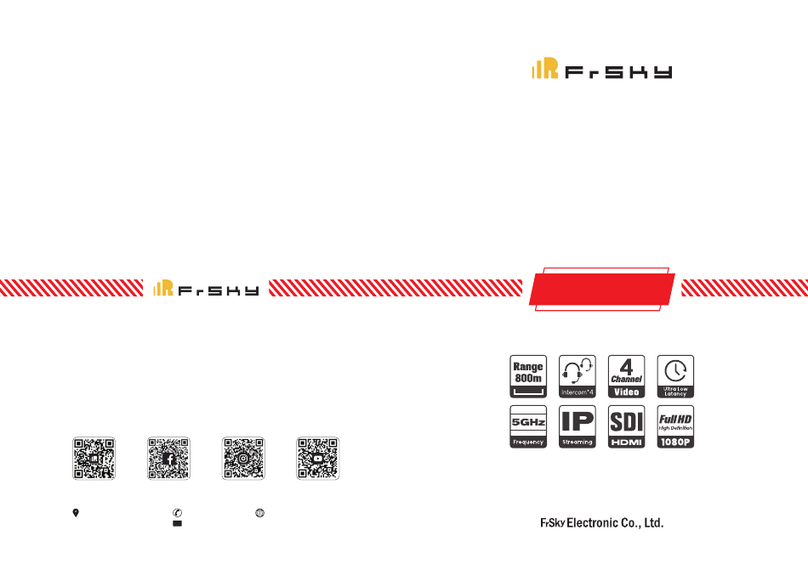
FrSky
FrSky Dragon Fire Series user manual
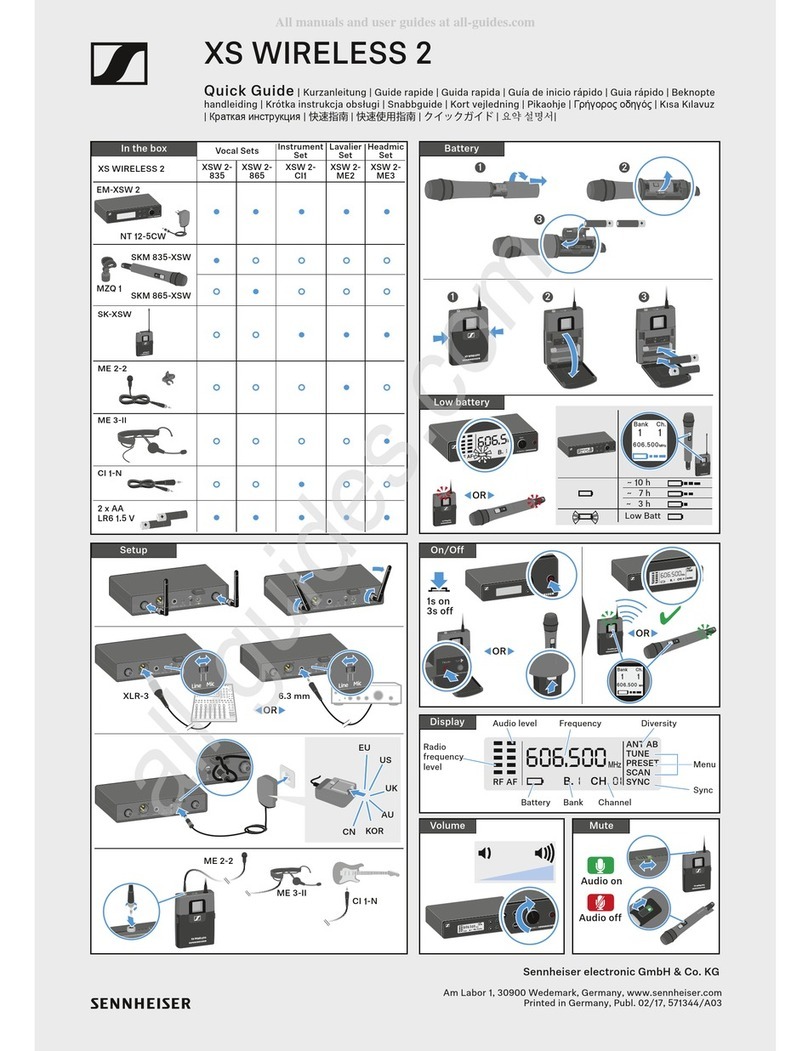
Sennheiser
Sennheiser XS WIRELESS 2 quick guide
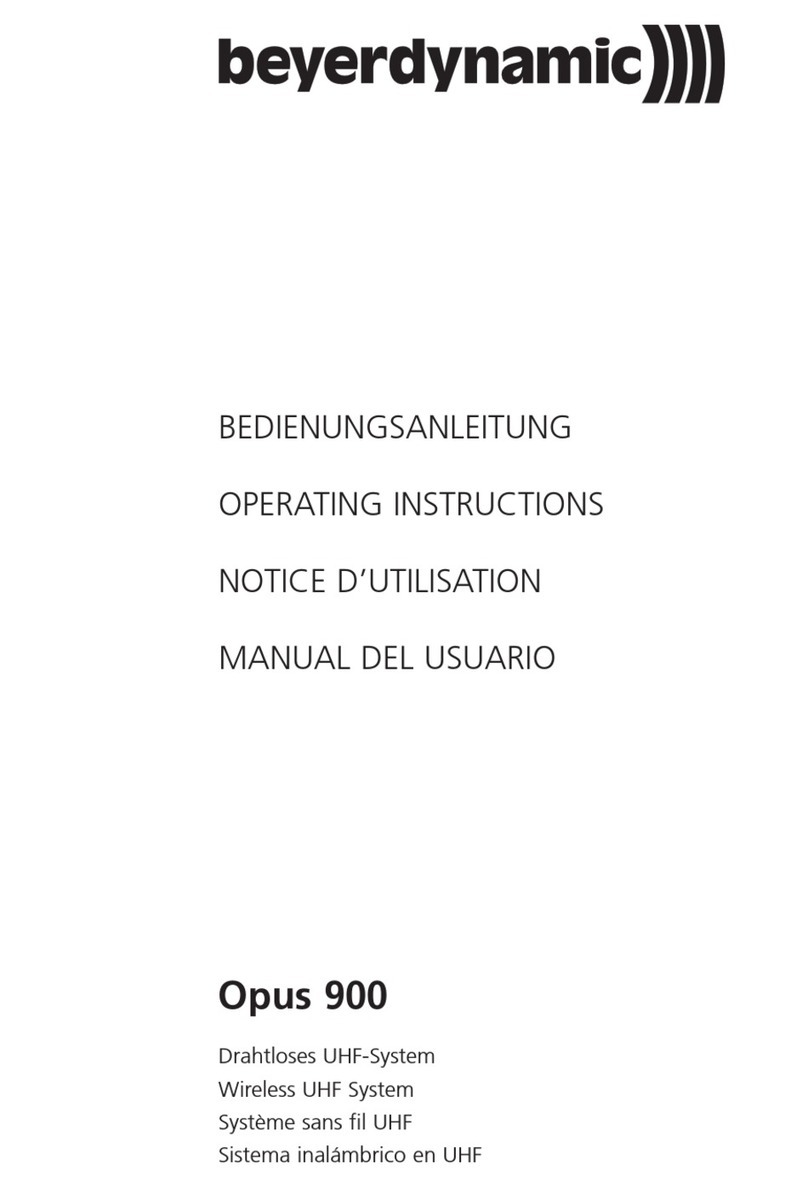
Beyerdynamic
Beyerdynamic UHF Wireless System Opus 900 operating instructions
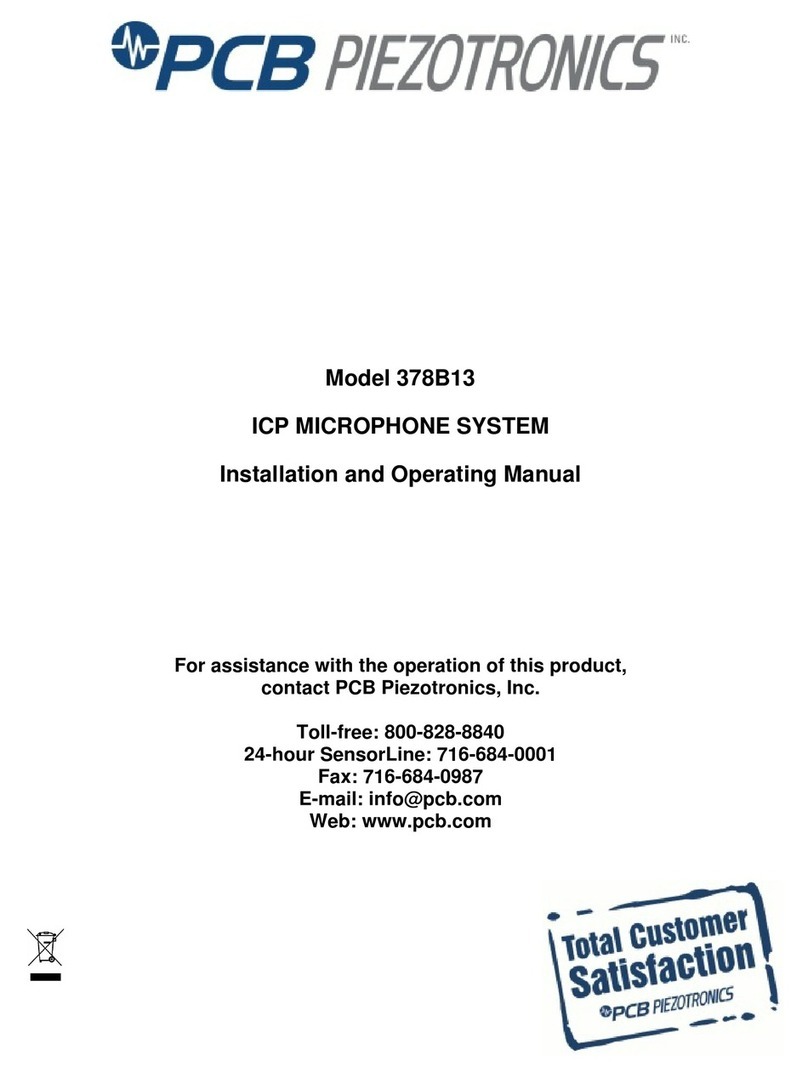
PCB Piezotronics
PCB Piezotronics 378B13 Installation and operating manual

INIM
INIM SAGITTARIUS VW2W instructions

Earthworks Audio
Earthworks Audio PM40 manual
